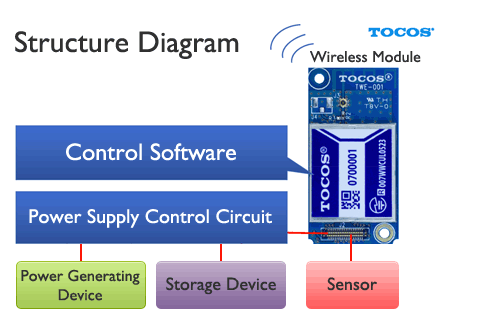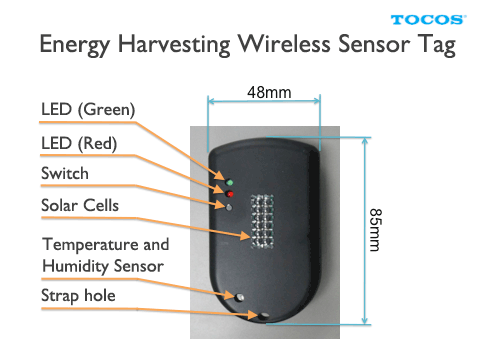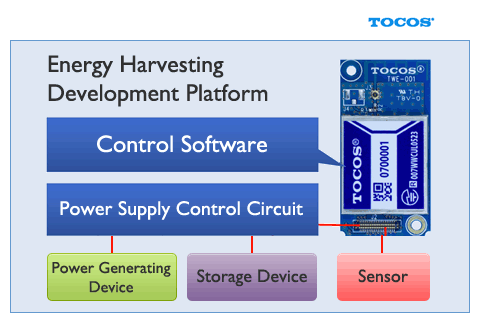Energy Harvesting Technology
Energy harvesting (also known as power harvesting or energy scavenging) is the process by which energy is derived from external sources such as solar power, illumination source, and vibration and heat generated by machines. The technology is especially intended to convert a small amount of energy in background ambience into power and utilize it.
Method of Energy Harvesting
There are several methods to obtain power with the energy harvesting technology. The following are four main energy sources:
Optical energy (Optical power generation)
The power generation technology that uses light energy as an energy source is called optical power generation, which harvests light energy from lighting such as solar light, incandescent lamp, fluorescent lamp, and LED to obtain power. There are various materials of a solar cell, ranging from silicon crystal type, silicon amorphous, dye-sensitized one, organic thin film, CIS, to CIGS.
Thermal energy (Thermoelectric power generation)
The power generation technology that uses thermal energy as an energy source is called thermoelectric power generation, which harvests thermal energy generated from a motor, engine, and other machines and from pipework of a building and factory to obtain power. The main one is power generation by temperature difference utilizing a Seebeck element (Peltier element).
Vibration energy (Vibration power generation)
The power generation technology that uses vibration energy as an energy source is called vibration power generation, which harvests vibration energy generated from a motor, engine, and other machines and from building structures such as a bridge and road to obtain power. Some use a piezoelectric element as a power generating element, and others use electrostatic induction or electromagnetic induction.
Radio waves energy (Radio waves power generation)
The power generation technology that uses radio waves energy as an energy source is called radio waves power generation, which harvests radio waves energy from a television, radio, cell phone, wireless LAN and so on to obtain power. Using a rectenna, radio waves energy is converted into direct current.
Energy Harvesting Wireless Sensor
The energy that these energy harvesting technologies try to harvest is very small, and therefore, the energy that can be gained is limited. Then, in what application can the small amount of energy be used?
One idea is to use the energy captured by energy harvesting technologies as power supply to a sensor network.
Wiring is always a problem when establishing a sensor network. It is ideal to eliminate the need of a signal line and power supply line, making it complete wireless (cableless). Combining with energy harvesting technologies will release you from the need of wiring and replacing batteries, getting a sensor network system closer to perfection.
Here are the elements necessary for an energy harvesting wireless sensor.
- Power generation device
- Storage device
- Sensor device
- Wireless module
- Power supply control circuits
- Control software

To make an energy harvesting wireless sensor work, a wireless module of very low power consumption is indispensable, for the energy you can get with a generator (harvester) incorporating an energy harvesting technology at practical cost and size is limited.
IEEE802.15.4 Wireless Module TWE-001 is a wireless module of low power consumption so that it can be driven by a small amount of power that can be gained from an energy harvesting generator (harvester).
Making the most of the super power saving feature of IEEE802.15.4 Wireless Module TOCOS Wireless Engine, we have been promoting the establishment of a development platform of a batteryless and cableless sensor network system that can operate on a very small amount of power to be obtained from environment energy using an energy harvesting technology.
IEEE802.15.4 Wireless Module TWE-001 operates at a voltage of 2.0 V - 3.6 V, consuming about 10 mA current on average when sending 1 packet of data and processing it in about 10 mS. Suppose it sends data once a second, the average consumption current will be about 100 μA, for once in 2 seconds, 50 μA, and for once in 3 seconds, 33 μA. The outstanding low power consumption contributes to the effective use of energy harvesting technologies.
The maximum data volume that can be sent in 1 packet is 112 byte. The data can be protected with powerful AES-128 bit encryption. The communications distance is up to 400 m at line of sight when using the compact pattern antennas built in the wireless module. With the use of external antennas, the communications distance can be further extended. Like this, the product provides high-level security and communications performance as well, boasting sufficient specs to establish a full-swing wireless sensor network incorporating energy harvesting technologies.
Energy Harvesting Sensor Network by (energy harvesting)
Energy Harvesting Sensor Network
The pictures below came from the demonstration exhibition of a wireless sensor network using an energy harvest technology at the Techno-Frontier 2011 Energy Harvesting Technology Trade Show (the only trade show in Japan regarding energy harvesting). Using a very small amount of power obtained with light power generation by a compact solar cell (24 x 9.5 mm), we conducted temperature sensor measurement and transmission over wireless radio waves. Even with the tiny room light in the venue, smaller than solar power, the data transmission was successfully conducted at an interval of about 10 seconds. (The transmission frequency differs depending on the light amount. The less light we can get, the less frequent.)
Furthermore, we created a star topology network at 1 vs many making the most of the feature of IEEE802.15.4 wireless communications, and monitored the temperature information at 100 points through a PC. Although there were many wireless LANs (WiFi) used in the venue, our network kept operating properly in an extremely stable state throughout the three-day Techno-Frontier 2011 trade show for energy harvesting technology (the only trade show in Japan regarding energy harvesting). It takes only 1 ms to transfer data of about 30 byte, so it can operate with no problem with about as small as 100 nodes.
We hope you will see that the wireless sensor network incorporating an energy harvesting technology can work properly in an actual situation through the demonstration.
 These are energy harvesting wireless sensors. We conducted a demonstration with 100 units in the show.
These are energy harvesting wireless sensors. We conducted a demonstration with 100 units in the show.
 The temperature information sent from the energy harvesting wireless sensors is displayed on a PC. When the data are updated, the data are shown in thicker color. If the measuring temperature is higher than the set temperature 28 C, it is shown in red, and if it is lower, in blue.
The temperature information sent from the energy harvesting wireless sensors is displayed on a PC. When the data are updated, the data are shown in thicker color. If the measuring temperature is higher than the set temperature 28 C, it is shown in red, and if it is lower, in blue.
 These are energy harvesting wireless sensor nodes. At the center, a compact type (24 x 9.5 x 5.1 mm) solar cell sphelar (Kyosemi) is installed. Of course, other types of harvesters (power generating elements) can also be used.
These are energy harvesting wireless sensor nodes. At the center, a compact type (24 x 9.5 x 5.1 mm) solar cell sphelar (Kyosemi) is installed. Of course, other types of harvesters (power generating elements) can also be used.
 This is the inside of an energy harvesting wireless sensor node. TWE-001 is mounted at the center. A battery is not attached here.
This is the inside of an energy harvesting wireless sensor node. TWE-001 is mounted at the center. A battery is not attached here.
With the IEEE802.15.4 Wireless Module TOCOS Wireless Engine at the core, we provide an energy harvesting development platform including power supply control circuits and control software to support your product development that uses energy harvesting technologies.
We are offering Sensor Network Evaluation Kit so that you can start the evaluation of a sensor network immediately. It can operate on energy harvesting as power supply.
Energy Harvesting Wireless Sensor Tag TWE-EK-EH-KYO is provided as an option for Sensor Network Evaluation Kit. With the software optimized for energy harvesting installed, it starts wireless transmission of temperature and humidity information by setting the harvester (solar cell) at a place where light shines on. Take advantage of the product to evaluate a wireless sensor system incorporating an energy harvesting technology.
- Product Name:
- Energy Harvesting Wireless Sensor Tag (with Kyosemi' s Sphelar mounted)
- Product Number:
- TWE-EK-EH-KYO
* The tag' s color may be different from the one in the picture.

Making the most of the super-low power consumption feature of IEEE802.15.4 Wireless Module TWE-001, the energy harvesting development platform can utilize various harvesters (generators) from light to vibration to temperature difference. Various sensors can be connected, not just a temperature sensor. As for an interface for sensors, there are a digital (I2C, DIO, UART, SPI), analog (12 bit ADC), and pulse (pulse counter) type input available. It can also be combined with a storage device (secondary battery).

Another way of utilizing the product is to combine with a primary battery and save the battery with an energy harvesting technology.
The energy harvesting development platform is a must for those who are considering developing a wireless sensor system incorporating energy harvesting technologies or establishing a demonstration system of various harvesters.
Related Products
Wireless Products
- Overview
- Wireless Products Overview
- Wireless Engine
- TWE Lite DIP
- TWE-Lite
- TWE-REGULAR
- TWE-STRONG
- Software
- ToCoNet
- TWE-ZERO
- Evaluation, Development
- Evaluation & Development Kit
- Sensor Network Evaluation Kit
- Antenna
- Avaliable Antennae
Technical Information
- RFID
- 920MHz_vs_24
- IEEE802.15.4
- Protocol Stack
- ZigBee
- Wireless Sensor Networks
- Energy Harvesting Technology
- M2M Wireless Communications
- HEMS / BEMS / FEMS / CEMS
- Internet of Things

